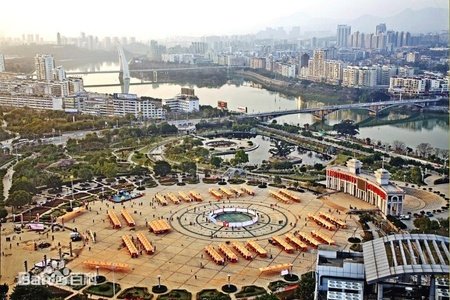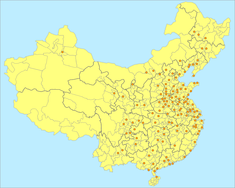
Every 1M+ Chinese City #7
First published: Monday April 3rd, 2023
Report this blog
Welcome to the seventh blog on 1M+ cities in China. Here I will go through 17 cities in the central and southern regions, including Hunan, Jiangxi, Guangdong and Hainan provinces, as well as Hong Kong.
Changde
Name
Simplified Chinese: 常德
Traditional Chinese: 常德
Pronunciation
Mandarin pinyin: cháng dé
Cantonese jyutping: soeng4 dak1
Population
citypopulation.de: 1,170,000
census 2020 (metro): 1,469,055
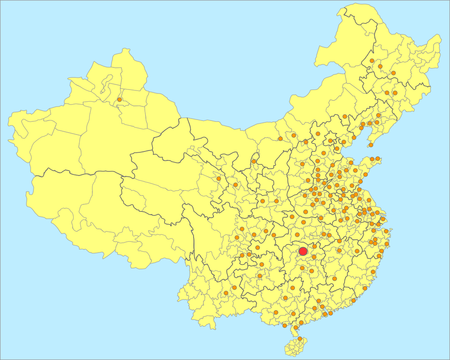
Changde was the site of the bloody Battle of Changde in WW2, where the Japanese used chemical weapons to clear their way.
Nowadays, tobacco is its most important industry, accounting for half of its industrial outputs. Other than that, it is not a well known city outside Hunan.
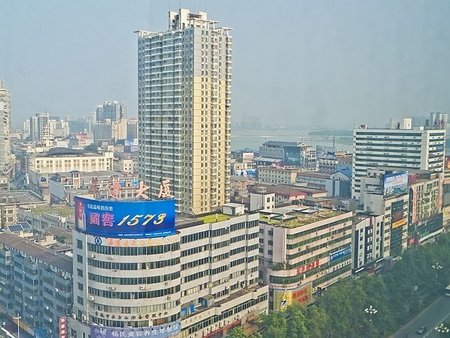
Yueyang
Name
Simplified Chinese: 岳阳
Traditional Chinese: 岳陽
Pronunciation
Mandarin pinyin: yuè yáng
Cantonese jyutping: ngok6 joeng4
Population
citypopulation.de: 1,170,000
census 2020 (metro): 1,335,692
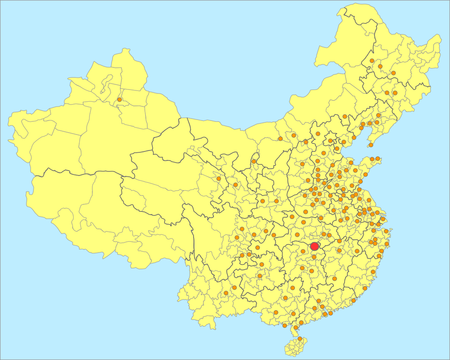
Yueyang is mostly known for its landmark the Yueyang Tower, overlooking the Dongting Lake. It was originally built in the 3rd century, and made famous by many poems and essays which are studied in secondary school.
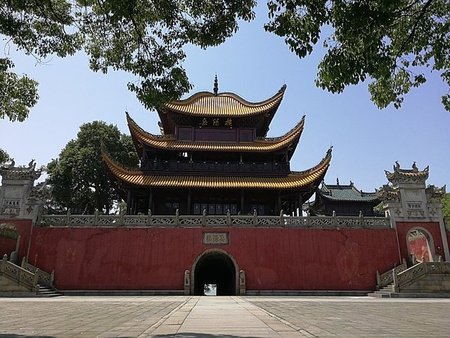
Jiujiang
Name
Simplified Chinese: 九江
Traditional Chinese: 九江
Pronunciation
Mandarin pinyin: jiŭ jiāng
Cantonese jyutping: gau2 gong1
Population
citypopulation.de: 1,020,000
census 2020 (metro): 1,164,268
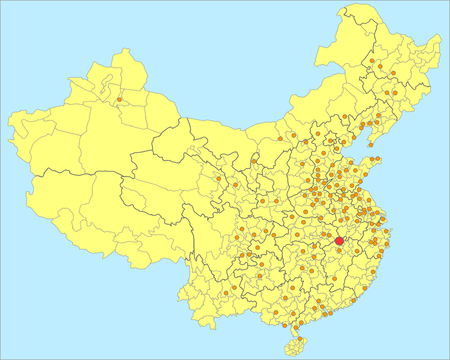
Jiujiang is on the southern bank of Yangtze River downstream from Wuhan. It is next to Poyang Lake, the largest freshwater lake in China.
There was a British concession after the Second Opium War. It was returned to China in 1929 after riots broke out two years earlier and the British lost control over their possession.
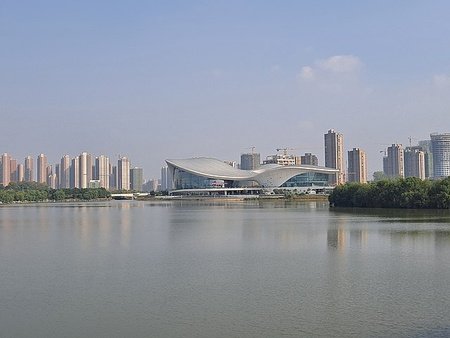
Changsha
Name
Simplified Chinese: 长沙
Traditional Chinese: 長沙
Pronunciation
Mandarin pinyin: cháng shā
Cantonese jyutping: coeng4 saa1
Population
citypopulation.de: 10,500,000
census 2020 (metro): 5,090,493
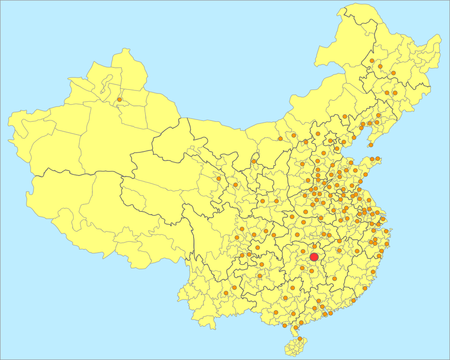
Changsha is the capital and the largest city of Hunan. Although it has over 2000 years of history, the city was completely destroyed when the Nationalist army set fire on the city to stop the advancing Japanese troops in 1938.
Today, Changsha is a modern industrial city, known as the "construction machinery capital of the world". It has a maglev train line built domestically using indigenous technology. The Hunan Satellite TV is one of the most popular TV stations in China, making Changsha an influential city in the Chinese mass media landscape.
Note that the citypopulation figure now includes the adjacent twin cities of Xiangtan (湘潭, pop. 1,099,892) and Zhuzhou (株洲, pop. 1,473,667), both were listed separately in previous years. Together, the three cities now form the Changzhutan metropolis with over 10 million inhabitants.
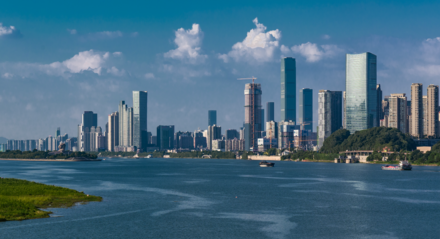
Nanchang
Name
Simplified Chinese: 南昌
Traditional Chinese: 南昌
Pronunciation
Mandarin pinyin: nán chāng
Cantonese jyutping: naam4 coeng1
Population
citypopulation.de: 4,800,000
census 2020 (metro): 3,929,660
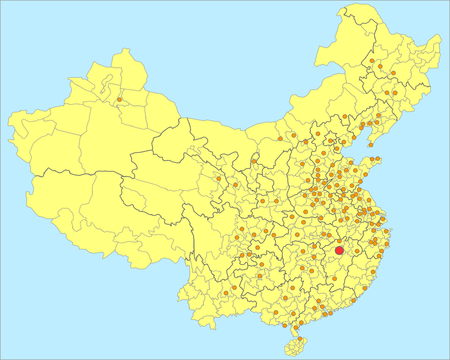
Nanchang is the capital of Jiangxi and the birthplace of the People's Liberation Army, which was born out of the 1927 Nanchang Uprising. It was the first engagement between the Communists and the Nationalists.
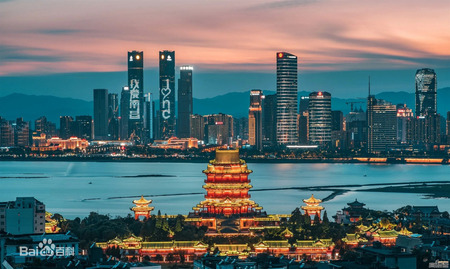
Shaoyang
Name
Simplified Chinese: 邵阳
Traditional Chinese: 邵陽
Pronunciation
Mandarin pinyin: shào yáng
Cantonese jyutping: siu6 joeng4
Population
citypopulation.de: 1,030,000
census 2020 (metro): 802,230

Shaoyang is a small and poor city in Hunan that most people have not heard of.
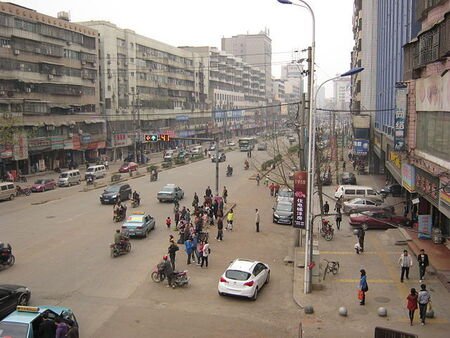
Hengyang
Name
Simplified Chinese: 衡阳
Traditional Chinese: 衡陽
Pronunciation
Mandarin pinyin: héng yáng
Cantonese jyutping: hang4 joeng4
Population
citypopulation.de: 1,220,000
census 2020 (metro): 1,290,715
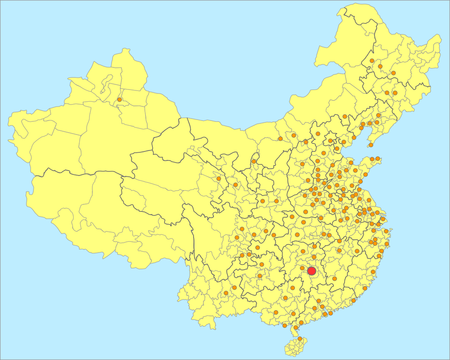
Hengyang is the second largest city in Hunan. It lies on the key route between Guangzhou and Beijing. It is named after Mount Heng, the southern mountain of the Five Great Mountains of China (similar to Tai'an and Mount Tai).
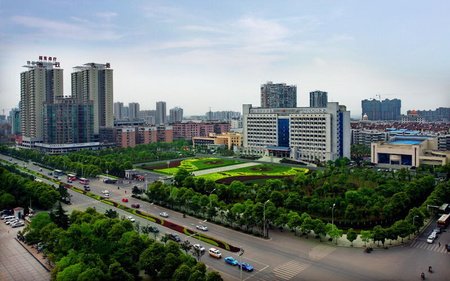
Ganzhou
Name
Simplified Chinese: 赣州
Traditional Chinese: 贛州
Pronunciation
Mandarin pinyin: gàn zhōu
Cantonese jyutping: gam3 zau1
Population
citypopulation.de: 1,980,000
census 2020 (metro): 2,588,060
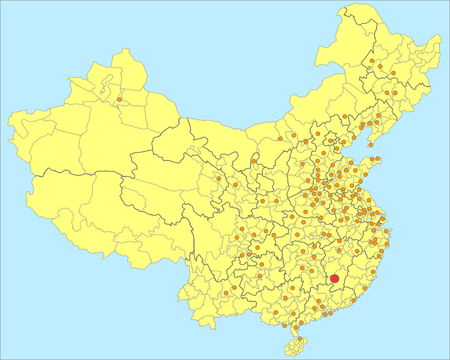
Shantou
Name
Simplified Chinese: 汕头
Traditional Chinese: 汕頭
Pronunciation
Mandarin pinyin: shàn tóu
Cantonese jyutping: saan3 tau4
Population
citypopulation.de: 8,000,000
census 2020 (metro): 5,437,602
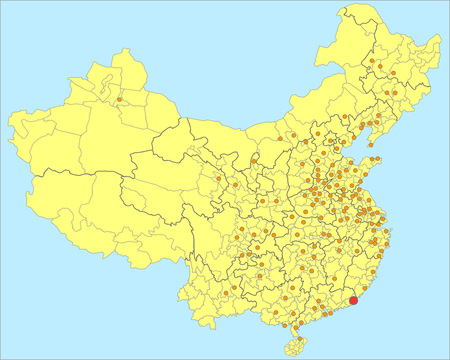
Shantou (or Swatow) is the largest city in eastern Guangdong. The area, including neighbouring Chaozhou (潮州, pop. 1,750,945), Jieyang (揭阳 / 揭陽, pop. 1,863,587) and Puning (普宁 / 普寧, pop. 1,998,619), forms one of the largest urban areas in China commonly known as Chaozhou (Teochew) or Chaoshan (Teo-Swa).
The locals speak a dialect of Southern Min which is unintelligible to the Cantonese in the west. Teochew people are prominent diaspora in Southeast Asia and Hong Kong. Li Ka-shing, the richest man in Hong Kong, came from here.
Shantou was one of the treaty ports after the Second Opium War, and one of the original Special Economic Zones established in the 1980s along with the more successful Shenzhen, Xiamen and Zhuhai.
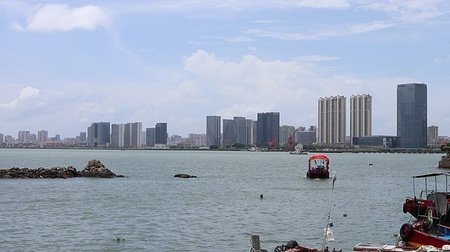
Hong Kong
Name
Simplified Chinese: 香港
Traditional Chinese: 香港
Pronunciation
Mandarin pinyin: xiāng gǎng
Cantonese jyutping: hoeng1 gong2
Population
citypopulation.de: 7,300,000
census 2020 (metro): 7,474,200
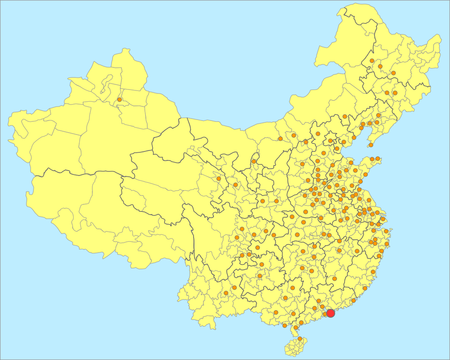
I have written many blogs about Hong Kong so I won't repeat myself here. This is the only top 100 city in the world that suffered significant population loss over the past two years, the reason which I explained before.
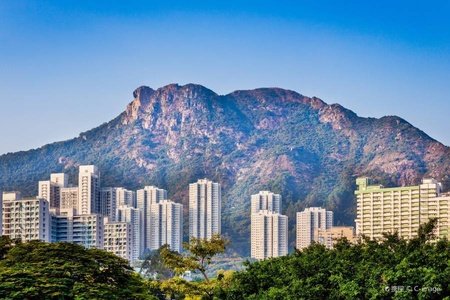
Zhuhai
Name
Simplified Chinese: 珠海
Traditional Chinese: 珠海
Pronunciation
Mandarin pinyin: zhū hăi
Cantonese jyutping: zyu1 hoi2
Population
citypopulation.de: 2,450,000
census 2020 (metro): 2,439,585
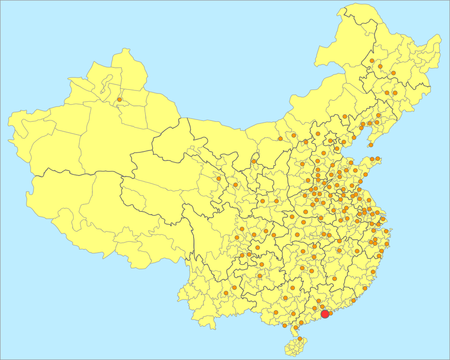
Zhuhai (literally means "pearl sea") is right across the border from Macau. It is less busy than its neighbours, and is popular with local tourists and retirees.
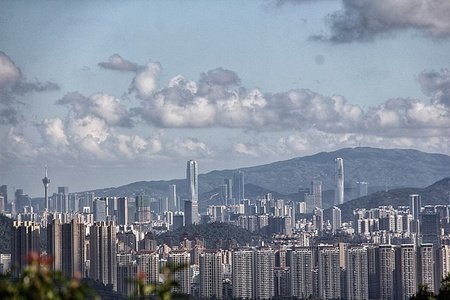
Guangzhou
Name
Simplified Chinese: 广州
Traditional Chinese: 廣州
Pronunciation
Mandarin pinyin: guăng zhōu
Cantonese jyutping: gwong2 zau1
Population
citypopulation.de: 67,800,000
census 2020 (metro): 18,676,605
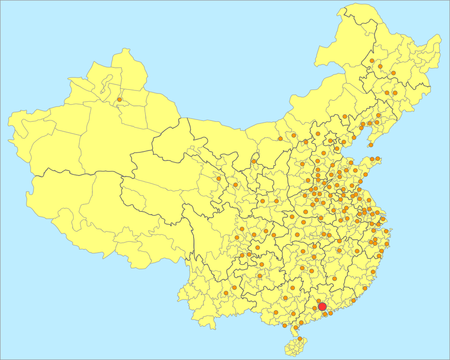
Guangzhou is a Tier-1 Cities in China (known as "Bei-Shang-Guang-Shen"). It is the central city of the Greater Bay Area, which I already explained in my previous blog so I won't bore you again. In addition to Shenzhen (深圳, pop. 17,560,061), Dongguan (东莞 / 東莞, pop. 10,466,625), Foshan (佛山, pop. 9,498,863), Jiangmen (江門 / 江门, pop. 2,126,978) and Zhongshan (中山, pop. 4,418,060), citypopulation has added Huizhou (惠州, pop. 3,494,715) to it, and the population is now 68 million compared to 48 million two years ago (more than the UK).

Qingyuan
Name
Simplified Chinese: 清远
Traditional Chinese: 清遠
Pronunciation
Mandarin pinyin: qīng yuăn
Cantonese jyutping: cing1 jyun5
Population
citypopulation.de: 1,270,000
census 2020 (metro): 1,738,424
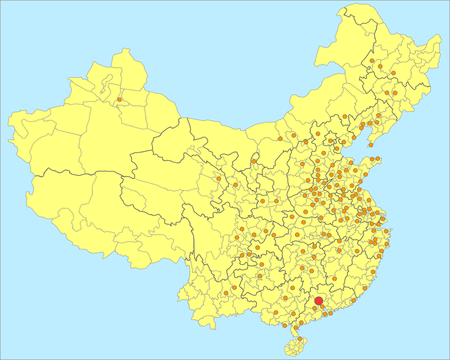
Qingyuan is only 65 km north of Guangzhou or 40 km from its airport. It is more like an outlying suburb of Guangzhou these days. Why it is not included as part of Guangzhou by citypopulation is baffling.
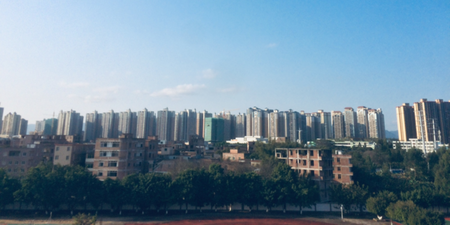
Zhaoqing
Name
Simplified Chinese: 肇庆
Traditional Chinese: 肇慶
Pronunciation
Mandarin pinyin: zhào qìng
Cantonese jyutping: siu6 hing3
Population
citypopulation.de: 1,100,000
census 2020 (metro): 1,553,109

Zhaoqing, which is 80 km west of Guangzhou, is the poorer cousin within the Greater Bay Area. The Seven Star Crags and lake are popular with tourists. Otherwise it is known for its giant sticky rice dumplings.
Again, I will not be surprised if this is added to Guangzhou in the future citypopulation listing.
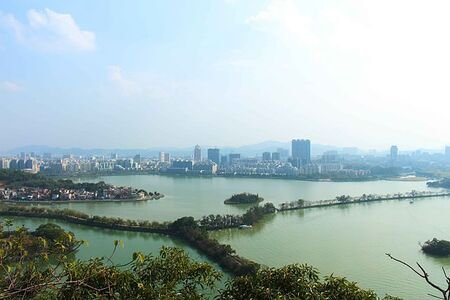
Maoming
Name
Simplified Chinese: 茂名
Traditional Chinese: 茂名
Pronunciation
Mandarin pinyin: mào míng
Cantonese jyutping: mau6 ming4
Population
citypopulation.de: 1,380,000
census 2020 (metro): 2,539,148
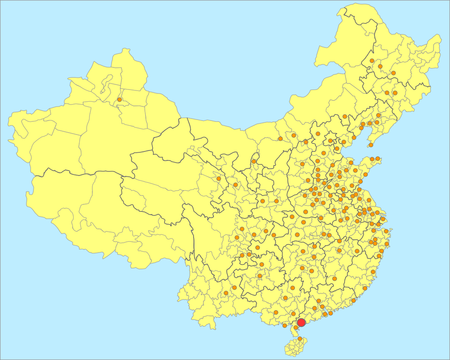
Maoming is a small city with the largest petrochemical plant in Southern China. Many of its working class population left the city to work in Guangzhou and Shenzhen. It is not a well known city outside Guangdong.
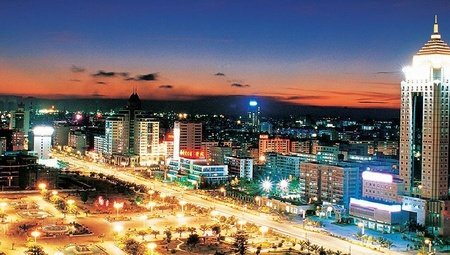
Zhanjiang
Name
Simplified Chinese: 湛江
Traditional Chinese: 湛江
Pronunciation
Mandarin pinyin: zhàn jiāng
Cantonese jyutping: zaam3 gong1
Population
citypopulation.de: 1,790,000
census 2020 (metro): 1,931,455
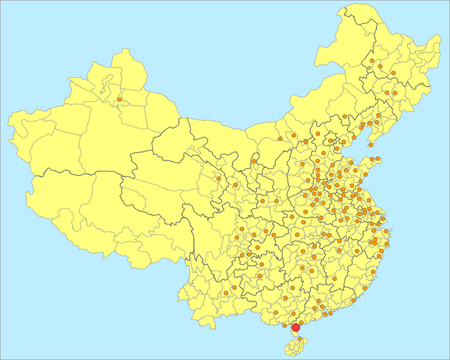
Zhanjiang, a port city at the northeast of Leizhou Peninsula, was leased to France as the territory of Kouang-Tchéou-Wan between 1898 and 1945. It used to be the second largest city in Guangdong, but its economy now lags behind the rest of the province.
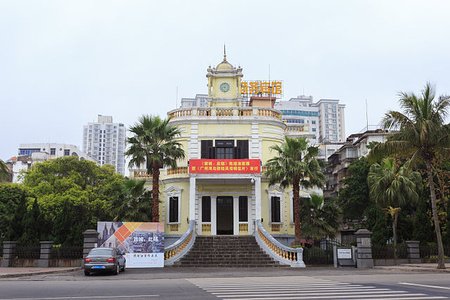
Haikou
Name
Simplified Chinese: 海口
Traditional Chinese: 海口
Pronunciation
Mandarin pinyin: hăi kŏu
Cantonese jyutping: hoi2 hau2
Population
citypopulation.de: 2,575,000
census 2020 (metro): 2,873,358
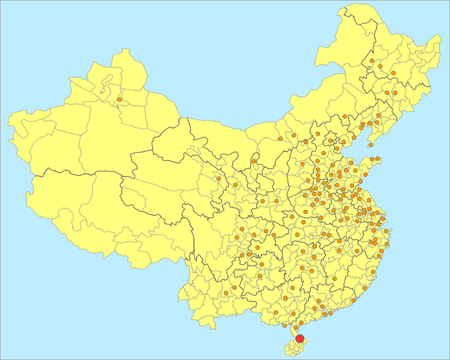
Haikou is the capital and the largest city on the Hainan Island, which was split from Guangdong as a standalone province in 1988. With a tropical climate, it produces coconuts, coffee and rubber.
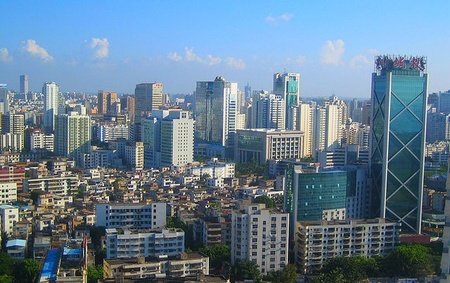
This concludes my second last blog of the series. In the final blog, I will go through the last 17 cities in Southwestern China, plus a short description of a few more cities that you should know but are not in the list. So stay tuned and thanks for reading.

